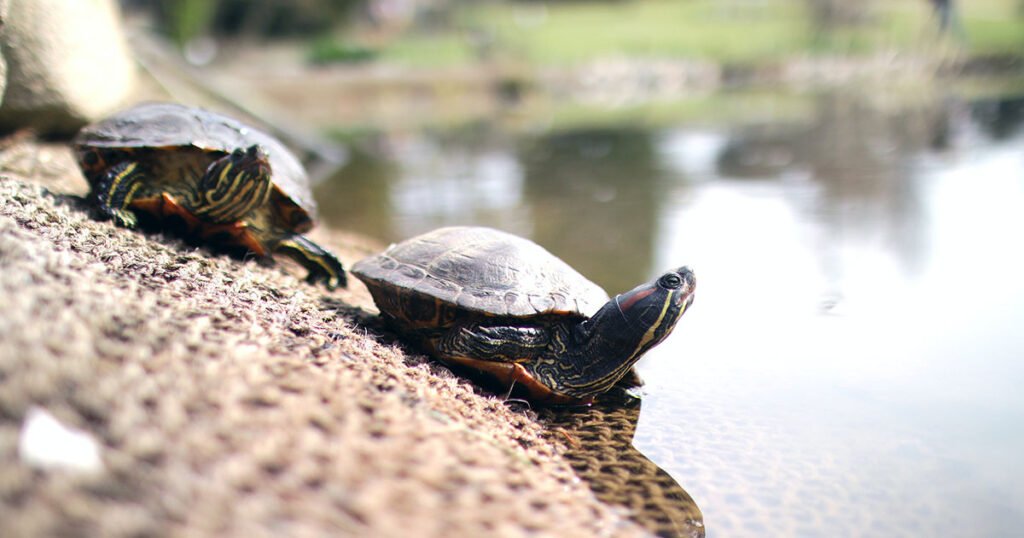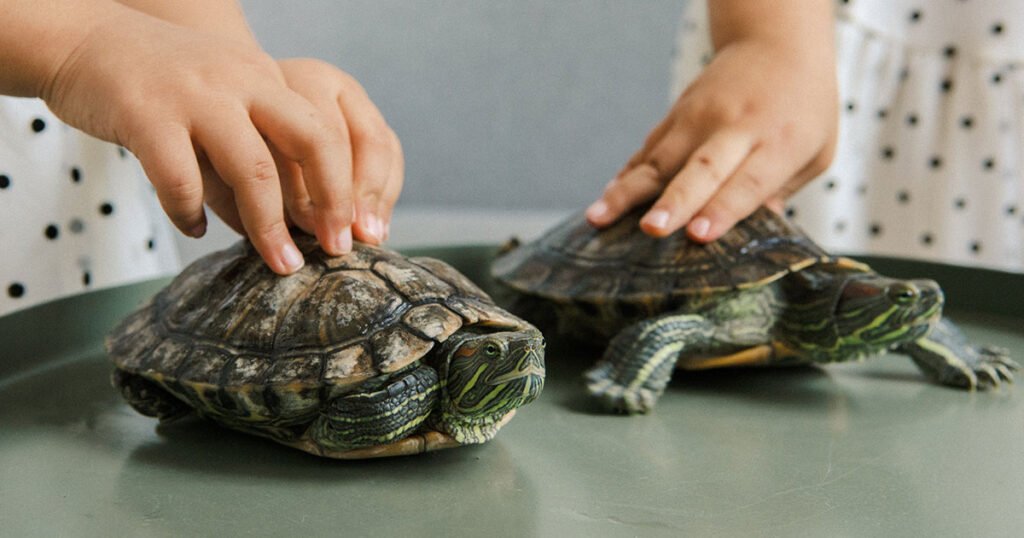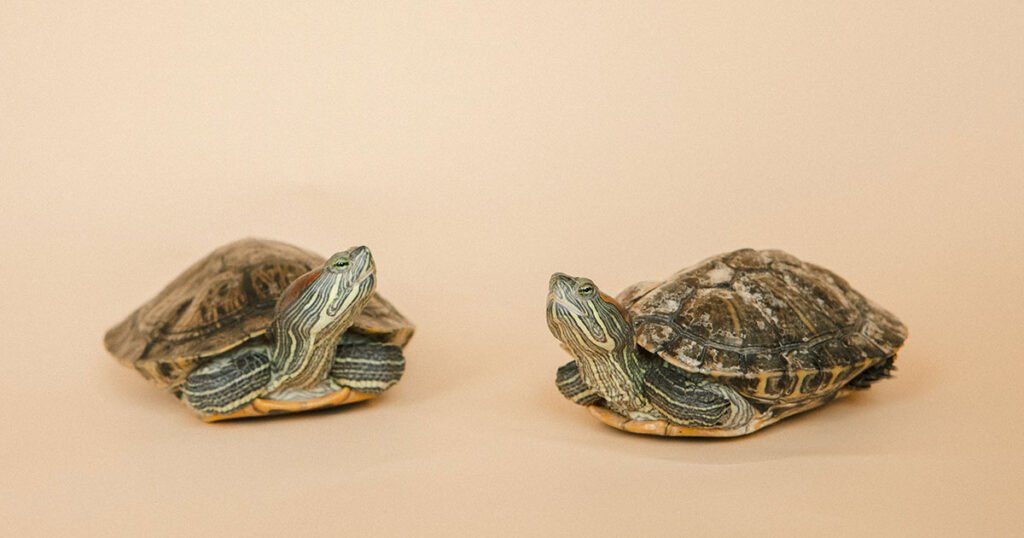Ever wondered about the tiniest turtles worldwide? The Reeves Turtles are delightful little creatures known for their charm and friendly nature! It is also known as the Chinese Pond Turtle or Three-Keeled Pond Turtle. You won’t find a cuter turtle than the Reeve turtle in East Asia. These days, turtles have become a favorite pet for many people. So, are Reeves Turtles good pets? If you’re considering getting one, the Reeves Turtle pet is excellent.
Imagine a turtle with a peaceful personality – these adorable turtles are the tiniest in the world! Sunbathing is their favorite activity, and they also eat pellets, greens, and insects or fish occasionally. Reeve turtles pet are easygoing and appropriate for beginners who want to keep turtles as pets. Interested in learning more about these adorable little turtles? Let’s explore more about the captivating Reeves Turtle!
Reeves Turtle Scientific Name & Origin

The Reeves Turtle is scientifically known as Mauremys Reevesii. It is a unique turtle that comes from East Asia, as we have mentioned earlier. Reeves Turtles originated from China and Korea, and people think they were brought to Japan and Taiwan long ago. Initially, some believed they were always there, but now they believe they were brought there later. It is thought that these turtles came to Japan in the 1700s from the Korean Peninsula.
Reeves Turtle Care: Eating Habits
Reeves Turtles have an omnivorous diet, which means they eat meat and vegetables. Their meals mainly consist of animal protein along with some green veggies.
You can find turtle feed or pellets at pet stores, and it’s essential to provide fresh foods like fish, shrimp, cooked chicken, lettuce, choy sum, redworms, and earthworms alongside commercial food. Adults need less meat and more veggies, while young turtles require a protein-rich diet.
How Often and How Much to Feed
Adult turtles should be fed every 1 to 2 days, while younger ones need daily food. When offering fresh food, feed them until they slow down eating; for dry food, provide just enough to finish in about twenty minutes.
Obesity and health issues can happen from overeating. Feeding them in a separate container is a good idea to keep the aquarium water clean.
Environmental Factors for Feeding
Maintaining the correct temperature aids digestion. Cold water can cause sickness or problems during hibernation. Providing appropriately sized insects, such as bloodworms, is essential.
Reeves Turtles are most active during the day, so it’s best to feed them then. Keep their swimming water clean using a good filtration system and treat tap water with a conditioner to remove harmful elements like chlorine.
Commercial Food and Supplements
A wide range of commercial turtle food is available, containing optimal nutrition for turtles of all ages. You should check the ingredient labels, ensuring they have around 30%-40% protein, low-fat content, Vitamin D, and a calcium-to-phosphate ratio of at least 2:1.
Reeves Turtles love animal and plant matter, including fish, worms, insects, green leafy vegetables, and aquatic plants like water lettuce, hyacinth, and duckweed.
Lifespan and Captivity

In the wild, Reeves Turtles can live for many years, even over 20. But when they’re kept as pets in captivity, they usually live around 10 to 15 years, and with reasonable care, they might live up to 15 to 20 years.
They might live up to 15 to 20 years with good reeve turtle care. These turtles can be great long-term companions if they get the proper diet, home, and care.
Read More: The Ultimate Guide To Cumberland Slider Turtle Care
Health Indicators for Reeve’s Turtles
When provided with suitable habitat and food, the Reeves turtle pet is an active and lively member in a tank. However, like any living being, they can fall ill. Here are signs indicating potential health problems:
- Eyes appearing swollen or sunken may indicate possible eye infections or health issues.
- Gaping mouth, frothing, or bubbles around the nose might indicate respiratory or oral issues.
- Unusual skin or shell discoloration, as well as open wounds, might suggest infections or injuries.
- Reluctance or inability to eat might indicate digestive or metabolic problems.
- Uneven or irregular growth patterns may hint at underlying health concerns affecting their development.
- Excessive basking or refusal to swim could signal discomfort or health complications.
- Any other peculiar behavior or appearance that deviates from their usual behavior should be checked for potential health issues.
If you are keeping a reeves turtle pet, immediately consult with a specialist for their well-being after noticing these issues.
Breeding Seasons and Availability of Reeves Turtle
Reeves Turtles usually have babies in spring and summer, just like many other turtles in cooler places. It means that if you want a baby turtle bred in captivity, the best time to find one is between May and September.
But you know what’s interesting? These baby turtles are around most of the year because so many are born yearly! And guess what? Even though they’re a bit special as exotic pets, they’re not too expensive to buy. You can purchase these Reeves turtles within the $60 – $200 range.
Physical Characteristics Of Reeve Turtles

Appearance Details
The Reeves turtle size is small; even the larger ones usually grow to about 9 inches long. The regular ones are usually around 6 inches long. It’s hard to tell if baby turtles are boys or girls just by looking at them.
Distinct Shell Features
Their shells are plain compared to other unique turtles. The shells are square and have three edges. They usually have colors like black, brown, or olive green. The lower part of their shell is a light cream color with dark spots.
Patterns and Head Details
Their heads can have different patterns. Sometimes, there are light spots on their heads, making them look speckled. These patterns might vary from turtle to turtle, adding a unique touch to each Reeves Turtle’s appearance. Some have more spots, while others might have fewer, giving them their distinctive look.
Adult Sizes
Male Reeves Turtle size extends to about 4.5 to 6 inches when they’re fully grown. Females can get a bit bigger, growing between 4.5 to 9 inches. The size difference between male and female Reeves Turtles is noticeable, but when they’re tiny babies, it’s hard to tell who will grow up to be big! It’s quite fascinating how they grow up to be different sizes.
Reeves Turtle Habitat and Behavior
Reeves Turtles like living in places that have ponds, marshes, and streams. They’re happy both in water and land, making them particular semi-aquatic creatures.
Housing Considerations
When you keep a Reeves Turtle in a tank at home, you can decide how simple or fancy you want to make their living space. But, there are some essential things to remember about the Reeves Turtle habitat. Because these turtles aren’t expert swimmers, keeping the water in the tank relatively shallow is better.
The water should be about three times the length of the turtle’s shell at its deepest. If the water is too shallow, there’s a risk that the turtle might not be able to turn over if it accidentally flips upside down.
So, the water should always be at least one and a half times the length of the turtle’s shell. They need a special place to leave the water completely, called a basking area.
Sunlight and Light
The Reeves Turtle habitat needs natural sunlight or special UV lights for healthy bone and shell growth. It’s essential to keep the basking area warm in winter, between 27 to 32 degrees Celsius. You can use a heat lamp to help the turtle warm up. Also, using an aquarium heater, the water should be kept between 24 to 29 degrees Celsius.
Space Requirements
You’ll need a large tank when you keep a Reeves Turtle as a pet indoors. As they grow, for Reeves Turtles care, more space is necessary. A single baby turtle should have at least 5 gallons of water, increasing the water volume as they grow.
Adults should have at least 20 gallons of water; more will be needed for additional turtles. It should have a part for swimming and another area where the turtle can come out of the water to dry and get warm.
Adaptability
These turtles can live in different types of tanks, like glass ones, garden ponds, sand surfaces, or plastic containers. But safety from other animals and preventing them from escaping is essential wherever they live.
Reeves turtle care is crucial if you want to take them as pets, and you have to set their living space accordingly.
Interesting Facts and Behaviors About Reeve Turtles
- Tiny Size: The Reeves Turtle size is the smallest among the turtle species.
- Basking Behavior: They enjoy basking under the sun or on a warm surface.
- Shell Retraction: These turtles can retract into their shells for protection.
- Social Interactions: They might live with other similar species in suitable habitats.
- Unique Features: Some have distinctive golden lines or markings on their shells.
- Distinct Behaviors: They’re active, yet might become still if they sense danger.
- Positive Fact: Reeves Turtles are generally peaceful and known for their dynamic and energetic nature.
Read More: 8 Best Types Of Pet Turtles
Wrapping Up
Reeves turtles can live with other turtles of similar species and housing needs, though they could be more social. They show territorial behavior, often exhibiting mild aggression, especially between genders.
However, with proper reeves turtle care ensuring enough space and hiding spots, this behavior typically doesn’t cause serious harm. If you are thinking about ‘Are reeves turtles good pets’ or looking for information on reeves turtles, we hope this post helps with your curiosity.
